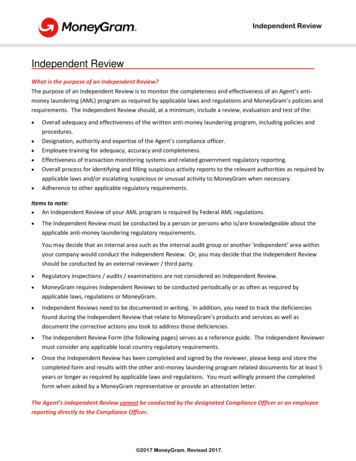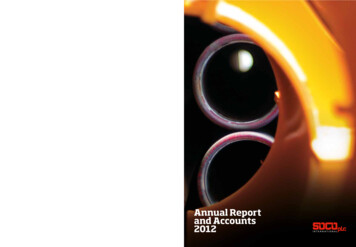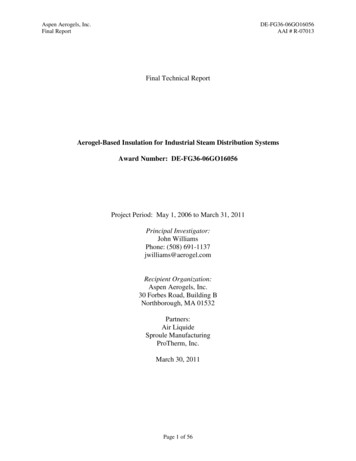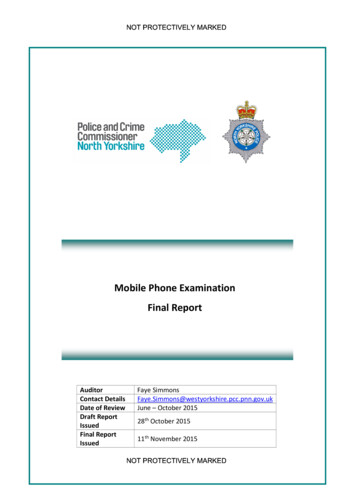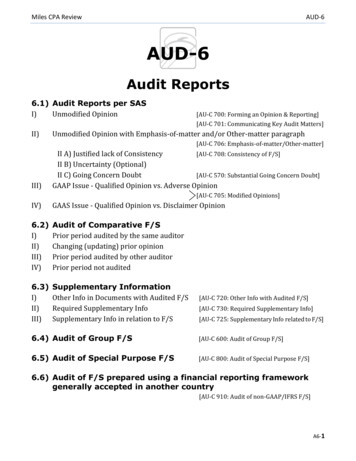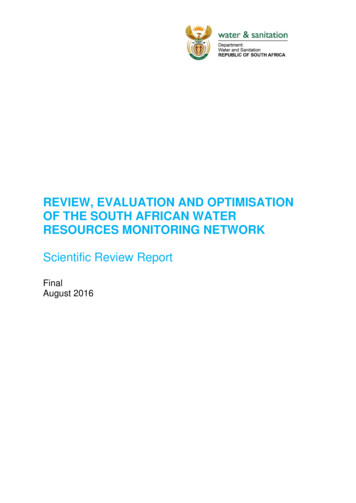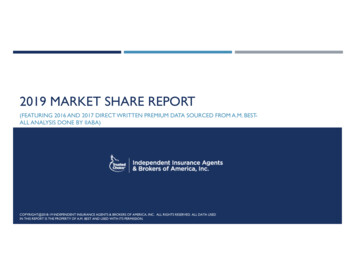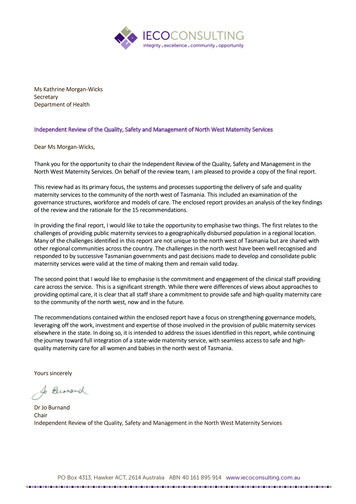
Transcription
Ms Kathrine Morgan-WicksSecretaryDepartment of HealthIndependent Review of the Quality, Safety and Management of North West Maternity ServicesDear Ms Morgan-Wicks,Thank you for the opportunity to chair the Independent Review of the Quality, Safety and Management in theNorth West Maternity Services. On behalf of the review team, I am pleased to provide a copy of the final report.This review had as its primary focus, the systems and processes supporting the delivery of safe and qualitymaternity services to the community of the north west of Tasmania. This included an examination of thegovernance structures, workforce and models of care. The enclosed report provides an analysis of the key findingsof the review and the rationale for the 15 recommendations.In providing the final report, I would like to take the opportunity to emphasise two things. The first relates to thechallenges of providing public maternity services to a geographically disbursed population in a regional location.Many of the challenges identified in this report are not unique to the north west of Tasmania but are shared withother regional communities across the country. The challenges in the north west have been well recognised andresponded to by successive Tasmanian governments and past decisions made to develop and consolidate publicmaternity services were valid at the time of making them and remain valid today.The second point that I would like to emphasise is the commitment and engagement of the clinical staff providingcare across the service. This is a significant strength. While there were differences of views about approaches toproviding optimal care, it is clear that all staff share a commitment to provide safe and high-quality maternity careto the community of the north west, now and in the future.The recommendations contained within the enclosed report have a focus on strengthening governance models,leveraging off the work, investment and expertise of those involved in the provision of public maternity serviceselsewhere in the state. In doing so, it is intended to address the issues identified in this report, while continuingthe journey toward full integration of a state-wide maternity service, with seamless access to safe and highquality maternity care for all women and babies in the north west of Tasmania.Yours sincerelyDr Jo BurnandChairIndependent Review of the Quality, Safety and Management in the North West Maternity Services
Independent Review of Quality,Safety and Management in theNorth West Maternity ServicesFINAL REPORT
Ms Kathrine Morgan-WicksSecretaryDepartment of HealthIndependent Review of the Quality, Safety and Management in the North West Maternity ServicesDear Ms Morgan-Wicks,Thank you for inviting me to chair the panel to review the North West Maternity Services. On behalf ofthe review panel, I would like to submit this report.This review had as its primary focus, the systems and processes supporting the delivery of safe andquality maternity services to the community of the north west of Tasmania. This included an examinationof the governance structures, workforce and models of care. The report provides an analysis of the keyfindings of the review and the rationale for the 15 recommendations.While the provision of safe and high-quality public maternity care to any regional community with adispersed population has a number of inherent challenges, these are amplified in the north west ofTasmania by complex governance arrangements, multiple models of care and longstanding workforceissues.The review team noted that there have been multiple past reviews and while there have been significantefforts to address concerns, many issues remain. Having said that, the review team were impressed withthe commitment and engagement of staff providing care to mothers and babies, often in very challengingcircumstances. Many staff recognise the need to address issues and in part, their voice (and distress) wasthe impetus for the review.The provision of safe and high-quality maternity services is everyone’s responsibility, including clinical andnon-clinical staff, managers, executive leadership and government. While it is recognised that the twoprimary recommendations will require a significant investment, the review team are firmly of the viewthat the time has come for definitive change. Importantly, this is a critical opportunity to move to a morefully integrated public maternity service for the whole of Tasmania, to address longstanding issues andprovide the community of the north west of Tasmania with seamless access to safe and high qualitypublic maternity services in the future.I would like to acknowledge those individuals, numbering over 60, who participated in the review andthank them for their contributions and engagement. I would also like to acknowledge the significant workand expertise of the review panel and finally, Rhonda Smith and Jenny Killworth for their assistance andsupport for the duration of the review process.Yours sincerelyDr Jo BurnandChairIndependent Review of the Quality, Safety and Management in the North West Maternity ServicesIndependent Review of the Quality, Safety and Management in the North West Maternity Services1
Executive SummaryThe provision of maternity services in the north west of Tasmaniahas a complex history with public inpatient maternity servicespreviously being provided across two sites, one of which isundertaken through a contractual arrangement with a privatehospital operator to provide intrapartum care of public patients atthe North West Private Hospital.In 2016, as part of a package of statewide health reforms, theNorth West Integrated Maternity Services (NWIMS) wasimplemented heralding a reconfiguration of public maternityservices across the region, including all inpatient services beingconcentrated to one site (NWPH) and a Midwifery Group Practice(MGP) established.There have been multiple concerns raised regarding the delivery ofmaternity services in the region, some with a focus on the licensingarrangements with the private hospital and this has been thesubject of multiple internal and external reviews spanning over 15years.The two compelling findings of the current review relate togovernance and workplace culture, both of which were ofsignificant concern to the review team.While providing safe and high-quality maternity care to a regionalcommunity with a dispersed population of known socio-economicdisadvantage has a number of inherent challenges, these havebeen amplified in the north west by multiple models of care beingdelivered at multiple sites, under complex governancearrangements characterised by opacity and lack of a single point ofaccountability.This is further compounded by longstanding workforce issues,difficulties recruiting and retaining a stable specialist obstetricworkforce in addition to workplace cultural issues.Put simply, the North West Integrated Maternity Services isanything but integrated.While broadly speaking, the elements of a clinical governanceframework were in place, there was significant evidence to supportthe lack of integration, with duplication of committee structures,lengthy times for investigation and lack of reporting back torelevant staff members.Independent Review of the Quality, Safety and Management in the North West Maternity Services2
The structure of clinical services, delivered across multiple sites,involving different models of care (which is to be encouraged), butunder a complex leadership and governance structure haspresented significant challenges to ensuring the delivery of safecare, despite the best efforts of individual clinicians. Many clinicians(medical, midwifery and others) currently working in the serviceraised concerns with the review team about their capacity todeliver safe care.Concerns held by clinical staff about their capacity to provide safecare appears to be taking its toll. There was evidence of a poorworkplace culture with hallmark features of fragmented servicesoperating within professional and organisational silos; blaming andmultiple interprofessional conflicts. The poor workplace culture isthreatening the very viability of the service through high attrition ofstaff and continued difficulties recruiting and retaining permanentstaff.It is clear that many of the issues identified in this review have beenlongstanding, evidenced by multiple prior reviews and while it isacknowledged that significant effort and progress has been madeto address some issues, a number of others remain unresolved.In giving consideration to the issues, the review team is firmly ofthe view that simply tweaking the service or committee structurewill not address the underlying structural and governance issues.More fundamental changes are required.After careful consideration, the review team recommend thatpublic maternity services should move to a single governancestructure and that this is best placed under the governance of theTasmanian Health System. It is recognised that this cannotpractically be achieved while the existing public private contract isin place and transition arrangements will need to occur withconsideration given to all parties.That said, it is hoped that moving the governance of all publicmaternity services under the Tasmanian Health Service will supporta more fully integrated public maternity service across the state,thereby ensuring equitable and seamless access to high quality andsafe patient care for all women and infants, regardless of postcode.It is also intended that the implementation of this recommendationwill increase opportunities for maternity services in the north westof the state to better connect with existing expertise in the deliveryof public maternity services at a state and national level, includingin the areas of policy development, clinical practice and clinicalgovernance functions. Further, a single employer model willsupport the development of a range of strategies to addresslongstanding workforce issues, including removing some of theIndependent Review of the Quality, Safety and Management in the North West Maternity Services3
barriers identified in the body of this report with respect toeducation, training and skill maintenance.While the NWIMS faces a number of challenges, the review teamalso noted a number of recent positive developments. Theyinclude:§The recent successful recruitment of 3 obstetricians, due tocommence during 2021. One of the successful applicants isknown to be strongly supportive of MGP models.§The relatively recent appointments to the Nurse Unit Managerpositions at both the NWPH and NWRH, with both positionsbeing job shared.§The capital works project with the build of a new antenatalclinic on the Burnie site and an expected completion of October2021.Taken together, these positive developments may provide animportant catalyst for a whole of service reset but will requiresignificant investment and support.The following recommendations are intended to address issuesidentified in the body of this report and provide a way forward toimprove the delivery of public maternity services to the north westTasmanian community.Independent Review of the Quality, Safety and Management in the North West Maternity Services4
RecommendationsRECOMMENDATIONSPrimary recommendationsNoRecommendationRelevant chapterThemePriorityTimeframe / Comment1A one employer and single governance structure, underthe Tasmanian Health Service, be implemented for theprovision of all public maternity services in the north westof the state. This aligns with the delivery of publicmaternity services elsewhere in the state and providesopportunities to move toward a more fully integrated andnetworked statewide service.Chapters 2, 3 and 4GovernanceHighGiven the significant amount of work required tomove to a single governance structure, preparatorywork should begin as soon as practicable, keeping inmind that the current contract expires in 2024.Commencement within 6 months.2A body of work is undertaken to address workplacecultural issues identified in this report with the aim ofunifying the service. It is acknowledged that significantinvestment is required to build a workplace culturereflecting the shared values and build the capacity for allstaff to work collaboratively across the maternity serviceto deliver high quality, safe patient care.Chapter 5Workplace cultureHighOne approach may be to engage a reputableorganisational psychology/executive coachingcompany to work with teams and individual staff toaddress current workplace issues and provide apositive foundation for the service moving forward.Commencement as soon as is practicable.Additional recommendations3The “special midwife” arrangements permitting anemployed midwife to provide clinical care to friends/familymembers above and beyond their employed hours of workare to cease. Staff who have been involved in thisarrangement to receive education regarding professionalboundaries as per NMBA expectations re DualRelationships and Boundaries.Chapter 3GovernanceImmediateRecommendation made to CEO and DON of NWPHat time of site visit. Review team advised that thiswas to be ceased at that time.4Significant work is undertaken to streamline models ofcare. This should include education of staff so thateveryone understands each component of the servicestructure.Chapter 3Clinical servicesMediumIt is anticipated that this will be an iterative processbut work should commence within 6 months.5Medical Emergency Team (MET) service to meetrequirements to provide appropriate and timely responseto acute clinical deterioration of maternity patients.Chapter 3Clinical servicesHighImmediate. There should be zero occasions where aMET service (or equivalent) is not available to NWPH.Independent Review of the Quality, Safety and Management in the North West Maternity Services5
RECOMMENDATIONSAdditional recommendationsNoRecommendationRelevant chapterThemePriorityTimeframe / Comment6Ensure that all midwives and theatre nurses have access torelevant education and training to support the delivery ofsafe and high -quality clinical care in all circumstances , forexample, care of a woman with an epidural, managementof obstetric emergencies in theatre.Chapter 3Education andtrainingMediumWithin 12 months.7The committee and clinical governance arrangements bestrengthened in line with the future service direction. Thereview team is of the view that the issues identified in thisreport are of such complexity, that simply restructuringthe existing committees will not address the underlyingissues.Chapter 4GovernanceMediumPending a decision on Recommendation 1.8The contract committee membership to be reviewed withthe aim to separate operational management fromcontractual functions. It is suggested that the THS berepresented by someone from within the Department,(albeit with contribution and advice from the relevantexecutive).Chapter 4GovernanceHighWhile it is understood that this recommendationmay be ultimately superseded through theimplementation of Recommendation 1, in theinterim, the contract committee will need tocontinue to operate effectively.9Credentialling arrangements of midwives to be reviewedand endorsed by the ACM professional body. These shouldremain in line with existing registration requirementsregarding Midwifery scope of practice through NMBA andAHPRA.Chapter 4GovernanceMediumWork to be commenced in second half of 2021.10Handover processes across the service to be strengthened.This should include establishing shared rules fordocumentation of management plans, alignment ofclinical care pathways with shared forms for all models ofcare across sites.Chapter 4Clinical servicesHighWork to be commenced in second half of 2021.Independent Review of the Quality, Safety and Management in the North West Maternity Services6
RECOMMENDATIONSAdditional recommendationsNoRecommendationRelevant chapterThemePriorityComment11Appointments to the senior positions of THS clinical leads(Head of Department and Midwifery DON) to beprogressed as soon as practicable. These positions willrequire significant support at all levels of the service.Chapter 5LeadershipHighPending a decision on Recommendation 1.12The Grade 5 midwife position for the Midwifery GroupPractice to be reinstituted and recruitment progressed.Chapter 5LeadershipMediumPending a decision on Recommendation 1.13Midwives on the north west are engaged and supportedthrough secondment arrangements to work at other siteswithin Tasmania. This might include for example, allowingfor a block of 4 weeks every 3 years to practice at othermidwifery service sites. This is in addition to engagementwith other professional development activities.Chapter 5Education andtrainingMediumWork to commence within 12 months.14Work arrangements for midwives be reviewed toencourage and support the capacity to work across the fullscope of practice.Chapter 5WorkforceMediumPending decision made on Recommendation 1.15Succession planning for the obstetric, anaesthetic andmidwifery workforce be undertaken. This will involve acomprehensive understanding of the demographics of theworkforce and planning for the future.Chapter 5WorkforceMediumWork to be commenced in second half of 2021,although it is understood that this recommendationhas interdependencies with Recommendation 1.Independent Review of the Quality, Safety and Management in the North West Maternity Services7
Table of contentsEXECUTIVE SUMMARY . 2RECOMMENDATIONS . 5TABLE OF CONTENTS . 8LIST OF TABLES AND FIGURES . 10ACRONYMS . 12PREAMBLE. 14IMPETUS FOR THIS REVIEW . 14PURPOSE . 16SCOPE . 16REVIEW METHODOLOGY . 17REVIEW TEAM . 18PURPOSE OF THIS REPORT . 19REPORT STRUCTURE . 19CONTEXT . 20INTRODUCTORY REMARKS . 20DEMOGRAPHICS . 20HEALTH STATUS . 22BIRTH DATA . 23SUMMARY . 24CHAPTER ONE: SERVICE CONFIGURATION . 25CLINICAL SERVICES PROFILE AND ROLE DELINEATION FRAMEWORK . 25NORTH WEST INTEGRATED MATERNITY SERVICES (NWIMS) . 27CLINICAL SUPPORT SERVICES . 28SUMMARY . 28CHAPTER TWO: REGULATORY FRAMEWORK . 30LEGISLATIVE FRAMEWORK . 30PREVIOUS INSPECTIONS OF NWPH . 31CONTRACTUAL ARRANGEMENTS . 31ROLE OF REGULATION, LICENSING AND ACCREDITATION UNIT . 32PRIVATE HOSPITAL COMPLIANCE AUDIT . 34CHAPTER THREE: CLINICAL SERVICE DELIVERY . 35MODELS OF CARE - OVERVIEW . 35ANTENATAL CARE . 35INTRAPARTUM CARE . 37POSTNATAL CARE . 39MIDWIFERY GROUP PRACTICE. 40KNOW YOUR MIDWIFE (KYM) PROGRAM – NWPH . 41PRIVATE OBSTETRICS. 41CLINICAL OUTCOMES . 42EMERGENCY CAESAREAN SECTIONS . 42ANAESTHETIC SERVICES . 43Independent Review of the Quality, Safety and Management in the North West Maternity Services8
EPIDURAL SERVICE . 43SPECIAL CARE NURSERY . 46EMERGENCY RESPONSE TO DETERIORATING PATIENT . 46TRANSFERS AND RETRIEVALS TO OTHER CENTRES . 47PHYSICAL ENVIRONMENT AND EQUIPMENT . 47RECOMMENDATIONS . 52CHAPTER FOUR: CLINICAL GOVERNANCE FRAMEWORK . 53ORGANISATION AND STRUCTURE. 54EXECUTIVE OVERSIGHT AND ACCOUNTABILITY. 54COMMITTEE STRUCTURE . 57POLICIES AND PROCESSES . 64AUDIT AND MONITORING . 65INCIDENT MANAGEMENT REPORTING . 66CREDENTIALING - MEDICAL STAFF . 71CREDENTIALING - MIDWIFERY STAFF . 71CLINICAL COMMUNICATION . 73SUMMARY OF KEY ISSUES. 74RECOMMENDATIONS . 75CHAPTER FIVE: WORKFORCE . 77MEDICAL WORKFORCE . 77MIDWIFERY WORKFORCE. 79LEADERSHIP AND MANAGEMENT . 82WORKFORCE CULTURE . 84EDUCATION AND TRAINING . 85RECOMMENDATIONS . 86APPENDICES . 88APPENDIX A: REVIEW TERMS OF REFERENCE . 89APPENDIX B: LIST OF SOURCE DOCUMENTS. 92APPENDIX C: LIST OF THOSE WHO CONTRIBUTED TO THE REVIEW PROCESS . 94Independent Review of the Quality, Safety and Management in the North West Maternity Services9
List of tables and figuresFigure 1Summary of key milestones and reviews into maternity services in the north westFigure 2Summary of review methodologyFigure 3Map of Tasmania showing population density of the stateTable 1Current chronic conditions by region, age standardised, 18 years and over,Tasmania 2019Figure 4Birth data for north west Tasmania for the period 2012 - 2019Figure 5Tasmanian role delineation framework service complexity levelsTable 2Summary of clinical services profile for maternity and neonatal services.Figure 6North West Integrated Maternity Services flowTable 3Number of caesarean sections for 2020Table 4Epidural rates for the period January – December 2020Table 5Birth statistics for NWIMS for 2020Table 6Admissions to
The provision of maternity services in the north west of Tasmania has a complex history with public inpatient maternity services previously being provided across two sites, one of which is undertaken through a contractual arrangement with a private hospital operator to provide intrapartum care of public patients at the North West Private Hospital.
